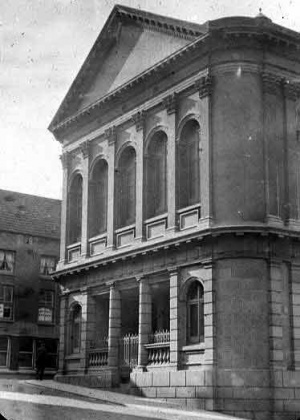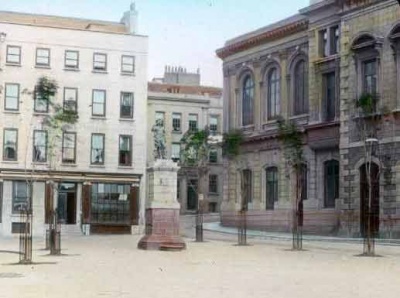Route
From the Museum walk on to the Weighbridge Square to look over Liberation Square, then turn right into Mulcaster Street crossing by the pedestrian crossing. Turn left into Bond Street and walk through the churchyard into the Royal Square. From the Royal Square return to the Museum via Broad Street.
"The Town lies fronting the sea, and is backed by a range of heights: but betwixt these heights and the town, there is a level, varying from a quarter of a mile, to a mile and a half, in breadth. This level forms a semi-circular suburb, the arch of which is not less than three miles; and the whole of this space is occupied by villas and cottage residences, with their gardens and orchards ." H D Inglis The Channel Islands, 1834
In the 19th century St Helier grew dramatically - the low lying area between King Street and the bottom of Mont de la Pouquelaye was infilled quickly with working class housing on the lowest lying areas and the better off middle class housing and those villas for the English residents being built on the surrounding slopes. Jersey had its own Irish quarter around Clare Street. Town gas was available from the late 1830s, by the middle of the century work was beginning on a modern drainage system and from the 1870s onwards piped water was brought into Town.
Development of the harbour
Jersey’s prosperity through the 19th century was dependent upon the development of the harbour here in St Helier. Originally the sea virtually extended up to the St Helier Churchyard wall and the only harbour was down in the area of South Pier and La Folie. Gradually new piers were built and the harbour was enclosed.
- Old North Pier was built between the 1790s and 1821 and was widened to create the New North Quay 1887-97
- Albert Pier was built between 1847 and 53. Originally named the West Pier it was named after the Prince Consort in 1859 during the Second Royal Visit.
- Victoria Pier was built between 1841and 1846. It was named by the Queen during the first Royal Visit to the Island in 1846.
- Commercial Buildings (Quai des Marchands) was built between 1814 and 1818 on reclaimed land. It was created to build warehousing and storage yards.
Liberation Square
Originally the site of the Weighbridge on which produce was weighed before being loaded on to the ships in the harbour. The Island Site was the St Helier terminal of the Jersey Railway Company 1870- 1936
- The old Tourist office was rebuilt in 1901 as the terminus of the Jersey Railway Company.
- Harbour Office was built in 1863
- Abattoir was built in 1888
- Southampton Hotel was built 1899 - typical 'seaside' architecture.
- Wharfe Street led down to the harbour and the wharfe (in front of what is now the Royal Yacht Hotel and the Museum.
- Royal Yacht Hotel was built in the 1820s but was largely rebuilt in the 1870s. It was on the roof of this building that the island’s first photography studio was set up in the summer of 1841.
- The Lamplighter was originally built in 1877 as Daly’s Hotel and was known as “The Grapes" / "La Grappe de Verjus". A local sculptor Jean Philippe "Turnkey" Giffard (1826-1892) created the statue of Britannia on the roof and carved the garlands of fruit which covered the front of the building, originally coming right down to the ground.
- Bond Street was largely occupied by shipping agents, and offices associated with Jersey’s shipping industry during the mid-19th century.
- The Town Church railings topped by the Gothic spires were designed by the Jersey artist John Le Capelain (1812 - 1848) and forged by Joseph Le Rossignol of Grandin’s Iron foundry in 1845.
The section at the end of the wall looks totally different because it was originally in the Gloucester Street Prison and was part of the screen that separated the male and female prisoners.
Royal Square
Initially called the market place. Best described as the most offensive part of town (because of the animal muck) until 1803 when the market was moved to Halkett Place. Nearby streets are called Coin des Anes and Coin des Cochons; Church Street was known as Rue Trousse Cotillons – Pick up your petticoats road.
Local writers described the square in a number of ways. In 1834 Inglis wrote that it was "the resort only of the male lounger". Forty years later Hill recounts that it was "generally used ... (for) . . . business and gossip.
States Building
Royal Court, States Chamber, Old library. Built throughout the Victorian period, the Royal Court (the central section) was built first in 1866 by architect Thomas Gallichan and remodelled in 1877 by Philip Le Sueur and Philip Bree). In 1879 it was extended to the east when the Judicial Greffe was built as a single storey building. Almost immediately it was decided that the States Assembly should have its own meeting room and so architects Ancell and Orange designed a new Chamber to be built over the Greffe.
This new States Chamber was opened in 1887. On the western side of the Royal Court another extension was built also by Ancell and Orange. This contained the States Greffe on the ground floor and a new Library above. This was completed in 1886. (The rounded façade facing the Church was only added in 1931.)
Before the present building appeared, the artist John Le Capelain (1812-1848) had a studio on the top floor of a building in the area of what is now the Royal Court.
Piquet House
Built on the north side of the square in 1803 the Piquet House housed a detachment of soldiers until 1834 and then again between 1887 and 1934 to help the Honorary Police in times of trouble.
Set into its wall there is a sundial, below which there is an inscription. This indicates that clocks should be regulated by reference to the sundial but only after the adjustment, “given in all the almanacks”, for the daily difference between sun time and clock time. These days the Equation of Time can be found online. A further adjustment must be made by adding eighty minutes because of the difference in longitude between Jersey and Greenwich. In summertime another hour has to be added.
1837 riot
In 1837 over 200 oyster fishermen from the Gorey area marched to the Royal Square where the States debated a petition containing their demands. The mood was festive until news that the petition had been rejected by one vote, and that one of those who had voted against it, despite having promised to vote for it was their own chef de police, Elias Gaudin. When Gaudin left the building the mob attacked him and he was only saved by the timely intervention of some friends and police who dragged him back into the building.
A St Helier centenier captured one of the ringleaders and dragged him to a nearby French coffee shop, locking the doors to prevent his rescue. The mob stoned the building breaking 13 of the windows but by this time 70 soldiers stationed at Fort Regent had answered the Bailiff's call for assistance and several more ringleaders were arrested. The soldiers brought the situation under control; the mob gradually dispersed and went home.
Broad Street
The bank buildings in this area are all Victorian although varying in style.
- Lloyds Bank 1858
- NatWest 1873
- HSBC 1884 and 1900
Le Sueur Obelisk 1855
The monument commemorates the work of Pierre Le Sueur as Constable of St Helier. He was elected five times and was instrumental in wiping out cholera by introducing sewers. The Lion heads were fountains to provide water for the horses – the cab stand was adjacent. The obelisk is aligned to be visible from the George II statue in the Royal Square.
Cholera
In 1832 with 16,000 of the Island population of 36,000 living in St Helier, the town was somewhat overcrowded in the poorer areas down by the quayside. The drainage of the low lying areas was rather sluggish with only a 3-inch to 100 yards drop. The population was boosted by immigrant English and Irish labour who were ineligible for poor relief and malnutrition and drunkenness were common. In this squalid environment the cholera epidemic broke out in Cabot's Yard in Sand Street.
In 10 weeks 806 cases were reported - over two per cent of the total population; 348 died - nearly one per cent; 90% of these lived in town. Of St Helier's 311 deaths, 267 were in Vingtaine de la Ville. The 1849 epidemic, which resulted in nearly 300 deaths, and the 1867 epidemic both followed the same pattern.



